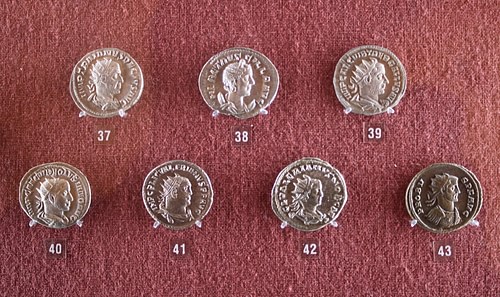Just as in other ancient civilizations, the first banks in Rome began in the temples consecrated to the ancient Gods. Many temples held in their basements the Romans' money and treasure, and were involved in banking activities such as lending. Because they were always occupied by devout workers and priests and regularly patrolled by soldiers, wealthy Romans felt they were safe places to deposit money. Money was commonly stored in various different temples for both practical and security reasons as a temple could catch fire or be ransacked. Priests kept track of deposits and loans. Temples did not pay interest on deposits but charged interest on loans and were involved in currency exchange and validation. There were literally thousands of temples throughout the Roman territories that were also repositories noting that during the Empire public deposits gradually started to be held in private repositories. The Temple of Saturn in Rome housed the Aerarium which was Rome's public treasury. Some temples such as the Juno Moneta temple were also mints.
THE ROMAN MONEY-CHANGERS: THE ARGENTARII
The development of commerce throughout the Mediterranean and the expansion of trade to new foreign markets between the 3rd century BCE and the 3rd century CE, led to the growth of banking in the Roman world. Aside from temples, money changers located at shops and stalls in the Forum also dealt with banking activities and their role gained greater importance with the development of commerce. Money-changers were preceded by the trapezites (from the Greek word trapeza which means counter), who dealt with bank transactions in counting houses around the Forum. The Greek term was later replaced by the Latin terms argentarii and mensarii (from the word mensa or 'bank' in Latin).
Three types of persons conducted banking activities in Rome: the argentarii, the mensarii and the nummularii. The argentarii, also called argenteae mensae exercitores, argenti distractores or negotiatores stipis argentariae, were private persons, free citizens, independent from the State. They belonged to a guild which accepted only a limited number of new members. The argentarii's main function was to exchange foreign currency for Roman currency (permutatio). They had shops or stalls around the Forum (owned by the state and built by the censors) and their role expanded over time to include almost every money transaction including holding money, lending money, participating in auctions, determining the value of coins (and detecting forged coins), and circulating newly minted money. Their job greatly resembled that of modern-day banks. There were argentarii of all kinds. Some were highly respected and from the upper class, usually the ones carrying out business on a large scale and for very wealthy people while some were looked down upon, usually the ones charging high rates and doing business on a small scale.
Permutatio or currency exchange was done for a small fee (collybus). The argentarii also became involved in bills of exchange (already common in Greece): they received a sum of money, for example, to be paid in Athens and they drew a bill payable in Athens by another banker in the Greek city. They had to know the exact value of a foreign coin in different places and at different times. The argentarii also kept money deposited by other persons (depositum), which could sometimes amount to very large sums of money, and made payments on behalf of other persons, just as modern banks do. Payments were made when the owner of the money told the argentarius or when the owner used a cheque (perscriptio) to make a payment. If two persons involved in a transaction used the same argentarius, the argentarius would record (scribere) in his books called codices (or tabulae, rationes) the transfer of money from one account to the other. The codices were very accurate; they recorded dates and every transaction. These records were looked upon as documents of high authority and used in courts of justice as unquestionable evidence. When the money was merely deposited, the argentarius paid no interest and the money was called vacua pecunia. When the money was deposited for an interest paid by the argentarius, the argentarius could use the money in other lucrative transactions (for example, loaning money to other persons).

ROME'S PUBLIC BANKERS: THE MENSARII
The mensarii (from the word mensa or 'bank' in Latin) were highly respected public bankers appointed by the state in special circumstances, usually in periods of general poverty, especially during periods of war, their goal being to help plebeians overcome economic difficulties and avert social unrest. We note that in ancient Rome plebeians carrying debt (nexum) could be exposed to slavery when they were unable to fulfil their debt obligations. The mensarii first appeared in 352 BCE. Quinqueviri mensarii, forming a five-man commission, were appointed and a public bank was created to address the problem of citizens' indebtedness. The citizens who could provide security were covered from public resources by the quinqueviri mensarii. The citizens who could not do so, transmitted their property to creditors after a reliable valuation was done by public officials. Later, the Lex Minucia De Triumviris Mensariis was passed in 216 BCE which appointed a commission of three people that operated continually until 210 BCE. Its function was the same as the quinqueviri mensarii and even wider.
Some of the functions of the mensarii were actually the same as the argentarii and even during ancient times people confused the two. For example, the mensarii held deposits (e.g. soldiers' pay), and they determined the value of coins and their genuineness. The mensarii's role was considered to be positive overall as they were able to address the problem of excess debt in the Roman economy. The names of some mensarii such as Gaius Duilius, Publius Decius Mus, Marcus Papirius, Quintus Publius and Titus Emilius were widely known in the Roman world.
THE OFFICERS OF THE MINT: THE NUMMULARII
The nummularii were officers of the mint and their main role was to test the quality of new coins. They held a bank that put new coins into circulation and took old or foreign coins in exchange for new coins. Just like the argentarii and the mensarii, they tested the genuineness of coins especially when large sums were involved in transactions. Many of their functions were the same as the argentarii: they exchanged money for their own account, held deposits, lent money, made payments on behalf of their clients, executed sales – especially auctions of property according to a deceased's will, executed payments at foreign places through local bankers, and they kept books (codex) which could be used as proof in courts.
CONCLUSION
Besides being places of worship, many temples were initially repositories where money was deposited and where most banking transactions were conducted. The Roman money-changers, the argentarii, took a more important role in banking activities as trade in the Roman world grew. Their role was very similar to that of modern-day bankers as they were involved in a wide variety of banking functions. The mensarii were public bankers appointed by the state in periods of general poverty in charge of solving the problem of citizens' indebtedness. They were in a way similar to the "bad banks" set up nowadays, often with public funds to address the problem of non-performing loans in the economy. The nummularii were officers of the mint and their main role was the circulation of new coins, a function also done by modern-day banks. In conclusion, it is quite remarkable how widespread the use of credit was and how developed and complex banking activities were in the Roman world. Banking greatly contributed to the development of commerce and trade, and to the creation of wealth in ancient Rome.









